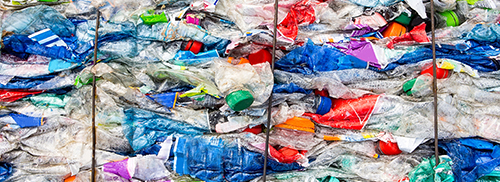
A joint Asphalt Institute (AI) and National Asphalt Pavement Association (NAPA) task force was formed in late 2019 to address the topic of recycled plastics in asphalt. The objective of the task force was to develop a document that would synthesize the literature and describe the current state of the knowledge while identifying knowledge gaps and future research needs.
AI and NAPA hired Dr. Fan Yin of the National Center for Asphalt Technology (NCAT) to conduct a comprehensive literature review on the use of recycled plastics in asphalt binders and mixtures.
This objective was completed in November of 2020 with the release of “Recycled Plastics in Asphalt, Part A, State of the Knowledge” and “Recycled Plastics in Asphalt, Part B, Literature Review.”
Both documents are available for free download on AI and NAPA websites. The authors were Dr. Richard Willis of NAPA, Dr. Fan Yin and Dr. Raquel Moraes of NCAT. Task force members provided technical review and comment.
The state-of-the-knowledge document provides a background, an overview of the waste plastic stream, a summary of the literature review, discussion of knowledge gaps and future research needs.
The literature review covers more than 110 research reports, journal articles, trade publications and magazine articles. Only documents written in English were included. A guidance table lists each study with the year of publication, authors, title, type of recycled plastics used, method of incorporating recycled plastics in asphalt and overall scope. A brief synthesis of each study is then provided discussing the scope of work, documented findings and recommendations.
Why the surge of interest?
Recycling is not a new concept, and certainly saving our natural resources is a trend that continues to become more mainstream in our daily lives. But why the surge of interest in using waste plastic in asphalt?
Starting in 2018, China banned the import of waste plastics from other countries. China had been taking and disposing of approximately 45 percent of the world’s plastic waste, equivalent to about 106 million metric tons annually. That amount of waste plastic must now find a new home.
While plastic production continues to rise, the world only recycles about 9 percent annually, with 80 percent ending up in landfills or the natural environment.
Trends in the U.S. mirror those globally. According to the EPA, in 2017 plastic accounted for 35.4 million tons of waste in the U.S., of which only 8.4 percent was recycled. This left 26.8 million tons that were landfilled and 5.6 million tons that were burned.
Over the last few years, companies with proprietary recycled plastic materials for asphalt binder and mixture modification have been aggressively marketing their products claiming a significant increase in pavement life compared to conventional mixtures.
The media helped spread this message that resonated well with the public – solving the waste plastic crisis while improving our aging roads. Many recent demonstration projects in cities received press coverage proclaiming the great solution, yet these projects often lacked the technical data necessary for a thorough evaluation.
Swell of new research
Plastic is not the first waste product that has been researched as an additive or modifier to asphalt (i.e. shingles, crumb rubber, etc.). Like all of them, engineering and science must lead the way in determining the most cost-effective and sustainable solution which certainly includes long-term performance. Accordingly, we have recently seen a swell of research activity to answer the many knowledge gaps around the use of recycled plastic in asphalt.
The Plastics Industry Association (PIA) has a project named New End-Market Opportunities (NEMO) that published a report in 2018 identifying the use of plastic film waste in asphalt as a new potential end-market opportunity. They have funded research at NCAT and other groups. Learn more at plasticsindustry.org/NEMO.
The Alliance to End Plastic Waste (AEPW) was founded in 2019 by over 80 plastic manufacturers from around the world. It is dedicated to finding innovative solutions to end plastic waste in the environment by working with scientists, engineers and other technical leaders. They have started research on the use of waste plastic in asphalt. Learn more at endplasticwaste.org.
The U.S. Federal Highway Administration (FHWA) is currently sponsoring research on the compatibility of asphalt binders with recycled plastics. This project focuses on the wet process. The National Cooperative Highway Research Program (NCHRP) has a pending project 09-66 to evaluate the impact of post-consumer recycled plastic, including LDPE (low-density polyethylene), HDPE (high-density polyethylene) and PP (propylene) on the performance properties of asphalt mixtures when added using the dry process.
Complex waste plastic stream
One of the common misconceptions is that all waste plastic is the same, consistent and appropriate for use in asphalt. This simply is not true.
There are many different types of plastic each with very different chemical compositions. The table shows the seven types of plastics identified by resin codes from the American Chemistry Council (ACC), along with their typical uses and melting point.
Each of these plastic types has many specific grades for their various uses. Physical properties vary depending not only on the type of plastic but also the grade within that type. Adding to the complexity and variability of characterizing the properties of the post-consumer plastic stream is that packaging is often a multi-layer system containing many different types of plastic.
Melting point is one of several physical properties important in the use of asphalt because if the plastic is supposed to modify binders, it will need to melt and become a homogeneous blend. Almost all asphalt mixtures are produced under 350°F and binders are stored at temperatures under 350°F as well, so many types of plastic will not even melt in a typical asphalt plant to blend with the binder or coat the aggregate.
The plastic types with a melting point well below 350°F are HDPE and LDPE. PP has a melting point at or just below typical asphalt plant production temperatures. Recent data from the EPA shows that roughly 29 percent of plastic in municipal solid waste is either LDPE or HDPE and roughly 32 percent is PP.
Melting point is just one of many physical and chemical differences between the various types and grades of plastics that affect how plastic may modify either the asphalt binder or mix properties. Thus, a consistent, clean and appropriate type of recycled plastic is critical when used to modify asphalt.
It is also important to mention that PVC (polyvinyl chloride), which is roughly three percent of the plastic waste stream, must not be run through an asphalt plant because it will generate dioxins in the exhaust gases that are harmful to human health and a safety concern.
Post-consumer plastic waste must be collected, washed, decontaminated and shredded, ultimately producing plastic flakes. The recycled plastics industry has standards to ensure a safe level of decontamination. The plastic flakes are sized and separated based on several physical properties. In many cases, the flakes are compounded into a new form, such as pellets and then used to produce plastic products or modifiers for asphalt. The more processing that takes place, the greater the expense of producing the plastic modifier for asphalt.
Summary of literature
Of the over 110 documents included in the comprehensive literature review, approximately 70 percent were published in the last 10 years. The five countries with the most documents were the United States (22), India (11), Malaysia (9), Canada (8) and China (8). The plastic types most studied were HDPE, LDPE and LLDPE (linear low-density polyethylene.) In terms of how the plastic was added to the asphalt, approximately twice as many documents covered the wet process versus the dry process.
The wet process refers to plastic being added into the asphalt binder as a polymer modifier or replacement. LDPE, LLDPE and HDPE are most suitable for the wet process due to their relatively low melting point. Dosage rates reported were between 2-8% by weight of binder, corresponding to roughly 2-8 lbs. of recycled plastic in a ton of asphalt mix.
The dry process refers to plastic being added directly into the mixture as either aggregate replacement, a mix modifier, binder modifier or as a coating to the aggregate. When plastics with a relatively low melting point are added via the dry process, the intent is binder or mix modification or achieving a plastic coating of the aggregate to improve moisture sensitivity. When plastic with a relatively high-melting point is added via the dry process, the goal is typically aggregate replacement. Dosage rates with the dry process were reported between .2 to 1 percent by weight of aggregate, corresponding to roughly 4-19 lbs. of recycled plastic in a ton of asphalt mix.
Regarding binder modification, a consistent finding in the literature was that plastic had a stiffening effect on the binder, thus potentially improving rutting resistance. There were very few studies that examined the effect of recycled plastics on binder properties related to fatigue or low-temperature cracking. Those that did showed a reduction in ductility with plastic modification, meaning a potential for greater cracking.
The literature on the wet process consistently reported an issue with phase separation between the plastic and asphalt, meaning difficulty in producing a homogeneous and storage-stable binder. To overcome this issue, some research incorporated a third component in the binder blends to act as a stabilizing agent.
In terms of how plastic modified mix behavior, much of the testing was simply using Marshall Stability. In most cases, plastic added wet or dry had a positive effect in terms of rutting resistance. For the wet process, this is due to a stiffening effect on the binder. For the dry process, the improvement could be attributed to increased friction within the aggregate structure, stiffening of the binder, or plastic coating of the aggregate. Again, very few studies examined how recycled plastics affected the cracking resistance of a mix.
Knowledge gaps
Based on a critical review of the literature, here are some of the more significant knowledge gaps.
Sourcing
Research is needed around waste plastic sourcing and recycling process for type, availability, consistency and cleanliness. Properties that seem to be most important for asphalt modification include melting point, specific gravity, ash content, particle size and crystallinity. Standards are needed to ensure a consistent and appropriate type of plastic modifier, which may be different depending on whether the wet or dry process is used.
Dry process
What production parameters affect dispersion, plastic coating of the aggregate and the extent of mix modification? How much modification occurs to the virgin binder? Since there are large differences in specific gravity between aggregate and plastic, how are key mix volumetric properties affected such as air voids and voids in the mineral aggregate (VMA)? What is the effect on moisture susceptibility, mix aging and cracking properties such as low temperature, fatigue, top-down and durability? How are plant production, field constructability and workability affected?
Wet process
Research is needed to overcome the storage separation issues stemming from the inherent incompatibility as well as the large difference in viscosity and density between plastic and asphalt. How will standard binder testing procedures need to be modified to properly characterize plastic modified binders? Are plastics compatible with anti-stripping additives, warm-mix additives and recycling agents? What are the fatigue and cracking properties of plastic modified binders? Another issue is that certain types of plastics are insoluble in solvents commonly used for the extraction and recovery of binders for lab characterization.
Environmental
Are microplastics generated and released in the air from milling operations of pavements that contain plastics? If so, it would be a serious impediment to the future recyclability of asphalt pavement. Can RAP from mixtures with plastic be run through a plant without concern for hazardous emissions? Are there other plant issues, such as coating the baghouse with plastic fines? Will there be leachates or microplastics from in-service plastic modified pavements, or from RAP stockpiles containing plastic modified asphalt?
Field performance
While there have been a large number of field projects with recycled plastics constructed, a more thorough and comprehensive evaluation of how these are performing over the long-term is needed.
Summary
It’s exciting to think that using recycled plastic to modify asphalt binders or mixtures could perhaps improve performance and even provide some small relief with the global waste plastic crisis. We must now make sure engineering experts and scientists drive logical decisions that are void of unintended ill consequences. Current research taking place in the U.S. and abroad will broaden our current state of knowledge and start addressing the current knowledge gaps.
Buncher is the Asphalt Institute Director of Engineering.













